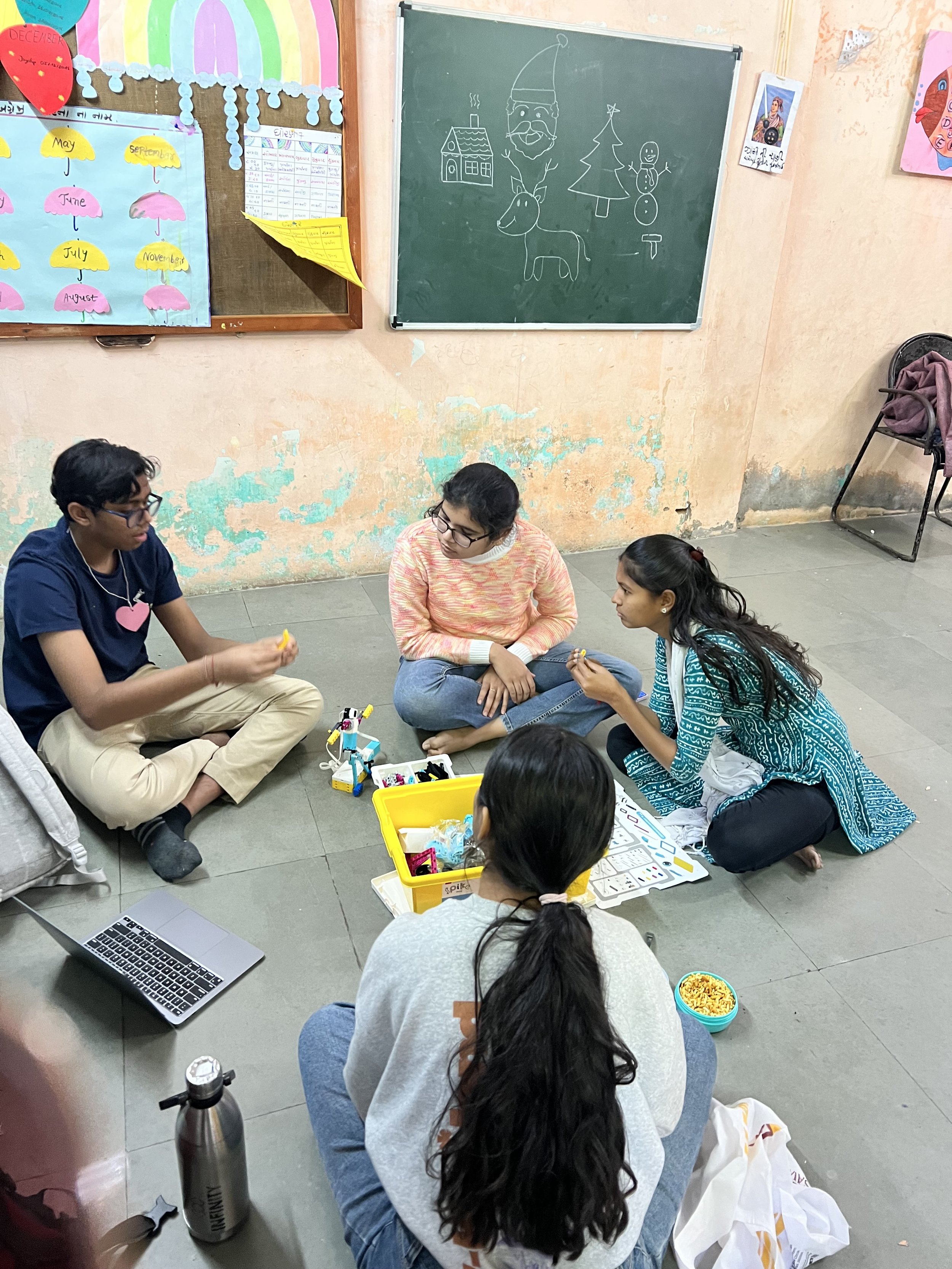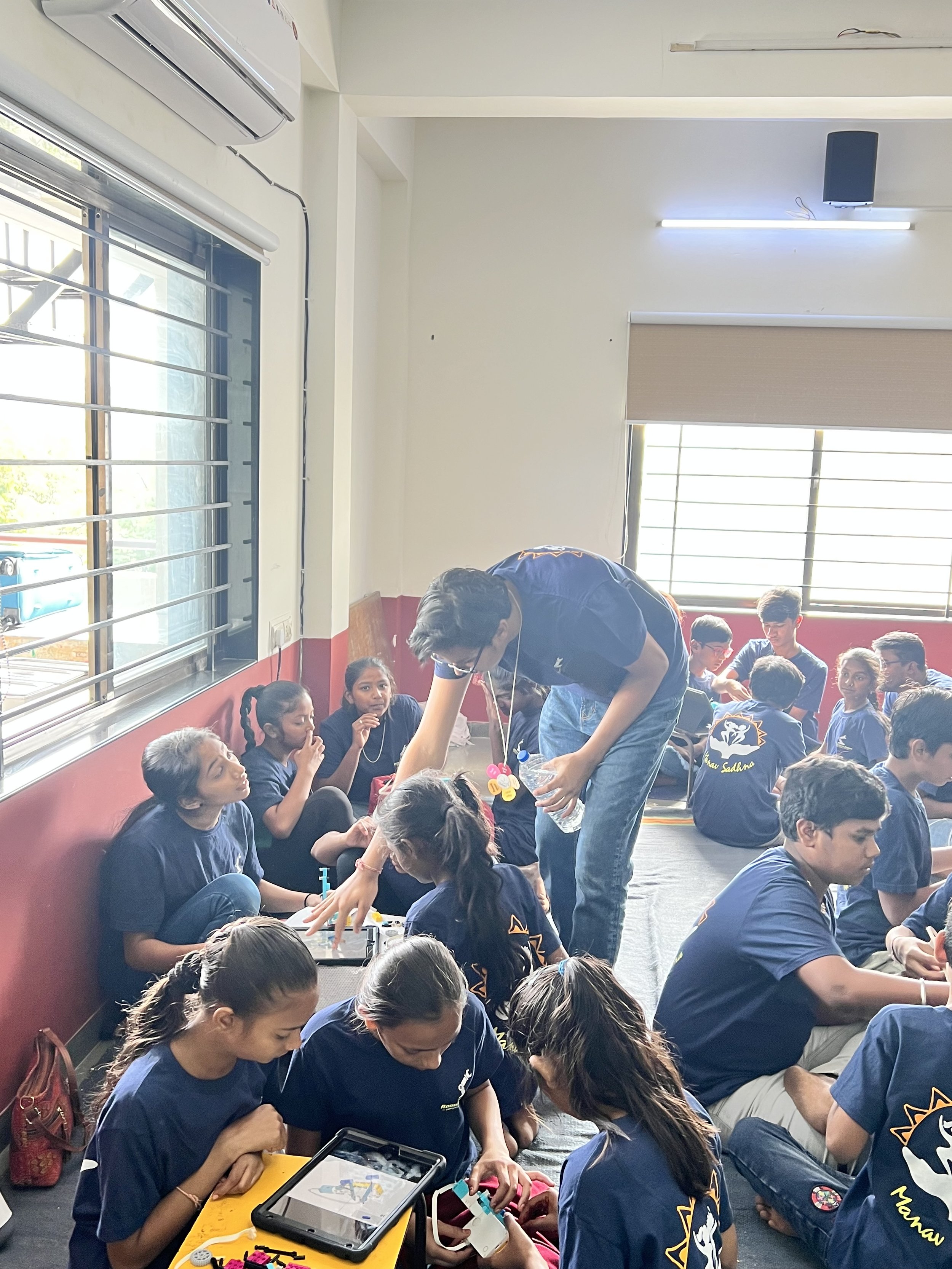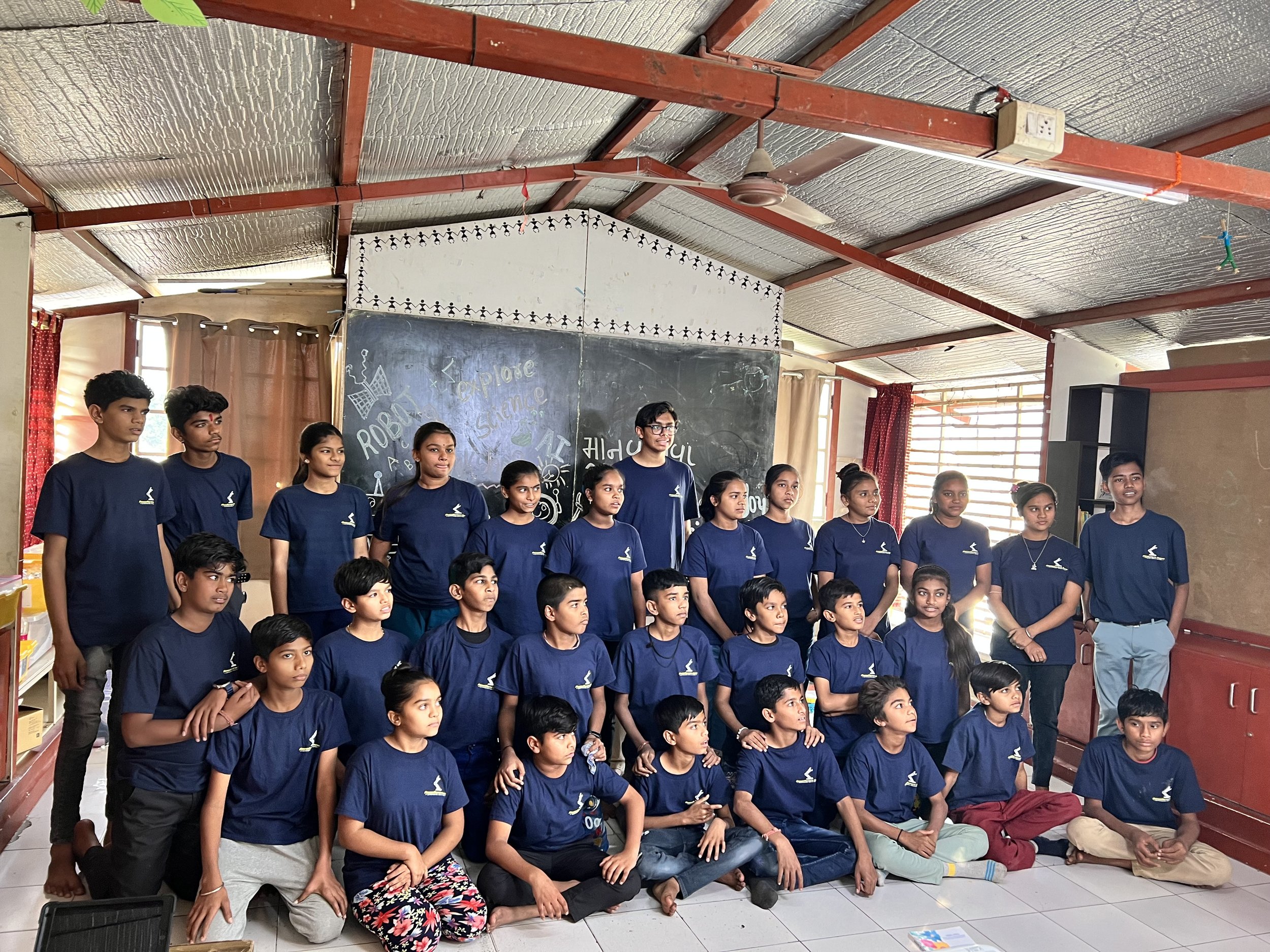Roboreach Blog:
First Post for Roboreach:
Hello everyone! This will be the newsletter for the Roboreach program, which will cover major programs and achievements.
Quick Thanks and Recognition:
First, I would like to start with some recognition. I would like to thank everyone who supported this project, all the people who generously donated to this cause, and everyone who has helped me along the way to achieve this goal of mine. We’ve far surpassed the intended goal, and for that I am extremely thankful. The overall goal was to expose underprivileged children in India to opportunities in robotics, coding and STEM learning. Thank you to Manav Sadhna, the organization that I worked with, who helped set up this project, and helped me create connections with the kids. Thank you to all the volunteers for helping me teach the kids. Thank you to the kids for being so curious and willing to learn, and putting me in such a enthusiastic environment. Thanks to all of these people, this project was a complete success. I had achieved my goal with the kids, and fostered a growth of interest in the STEM field. The STEM field is very important for paving the way to jobs in fields such as engineering, robotics, and the sciences.
Current Finances:
I would like to again thank everyone who supported this project though donations, with all your support, we have far surpassed our original goal of $10,000 by $5,000. We have spent around $9,500 so far on the combined robotic kits and expansion sets ($5000), iPads and covers ($4000, more expensive because we had to get them in India), and $300 to buy lunches and ice creams for the kids at every center. We still have $5053 dollars in spending money, which we plan to use weekly to transport kids and fund a teachers salary.
A Recap of Each Day:
As everyone may know, I visited 5 different centers (a center is embedded in a major slum area) for every weekday. I will talk about my experience and process at each center, then will talk about the overall experience.
Manav Mitra: Day 1
Manav Mitra was my first day, and I was extremely nervous. The center was located in a slum next to the Narendra Modi Cricket Stadium, the largest stadium in the world. I arrived really early that day at around 10 to meet with some volunteers and the translator I would be working with. (Since my knowledge of Gujarati, the state's foreign language, was limited to only speaking I had needed a translator) I taught the translator the curriculum, which I have posted below, and we waited for the kids to finish schooling. I was teaching in an open courtyard. The lesson promptly started at 1:30. Some of the teachers first introduced me to the kids, where I was from, what I would be teaching them and for the kids to give me their attention. After this, we carried on with the curriculum.
I observed the kids at Mitra as shy, but still curious. They were very cautious and careful when they built, but as the lesson went on they became much more joyful and creative. We reached the first part of coding when suddenly the first problem occurred. A technical error had made itself apparent, which did not allow for inputs from the Ipads to reach some of the robots themself. This meant that coding would not be possible. Luckily, I had realized this error at the start of the lesson, and a volunteer from Germany, who was an engineering student from the technical university of Munich had stepped up to try and solve this. He worked on it while the rest of us taught the kids. Sadly, he managed to solve the error after the kids had left. We stopped the lesson early, at the dancing robot. and I was devastated, yet the kids were not sad at all. I asked a few of them and they said they were very thankful that I had given them this opportunity, and that they had felt so much fun to build and see the dancing robot move.
Manav Gulzar: Day 2
Today, I was a lot more confident with teaching. The center was located in a slum on the riverbank of Ahmedabad, one of the city's biggest slums, with a population of 3k+. We arrived later, at 12:30, had lunch in the slum, and waited for the kids. This would by far be the largest center I had visited. It spanned 8 different buildings with a large courtyard in the center. I taught right in a building over the courtyard, with an open window space, therefore meaning that a lot of noise from the lower courtyard leaked into the room. When the kids first came, they were very energetic and loud then the Manav Mitra kids. It took the volunteers much more time to quiet them down. Somehow there were even more kids than there were supposed to be, around 32 kids. The main center leader explained that these kids come from less rougher places than the Manav Mitra kids, and these kids also have more sheltering and help, which made them more happier and willing to learn. We managed to finish the entire curriculum for this day in around 5 hours, and made it through the day with very few problems. Below I have shared a video of the experience at the center.
Manav Gulzar was also visited this day by the Manan family, who are from Boston, with two little kids. Both of these kids, named Sean and Devin, helped tremendously in controlling the kids and helping them navigate the iPad and tech with their masterful knowledge. Thanks guys!
Manav Setu: Day 3
For today's center, I was facing a big situation. The food that I had eaten in the slum had made me sick. The night before, I was weighing the decision to come or not to come but I decided to pull through and go anyway. This center was located underneath a bridge which was an overpass on the Sabarmati river. This meant that it was very noisy. It was also very close to Manav Gulzar. Since the slum was so big, these two different centers were located in the same slum. We arrived at around 12:30, and started setting the kits up. The kids arrived at 1:30. I observed these kids to be much quieter than the Manav Gulzar kids, but they were still curious about learning. Through the entire lesson while the kids were quiet you could still hear the cars driving above. I did not feel well for most of the lessons so I sat down on a rolling office chair and moved to whoever needed help. I followed the same curriculum as the other two centers, And through my sickness managed to teach the entire curriculum for 4 hours. One key moment I promptly remember during this center was when I was teaching a group how to build something, and one of them accidentally turned the motor on and broke the entire robot that they were building. Both of the other kids looked back at him as his expression changed. It was absolutely hilarious!
Loving Heart: Day 4
Today, the kids from Loving Heart Center were moved due to reconstruction of homes in the slum that the center inhabited. Therefore the kids were situated at the Manav Sadhna main base, which was an office building. I was feeling a lot better after a night of rest. I taught in a very confined space, roughly the size of a bus, but somehow there were less kids this time, only eight groups instead of nine. The environment was very loud due to being in that confined space as well as a board meeting going on outside at the same time. I observed these kids to pick up the lessons I taught the fastest, but also followed directions the best. By today, I had perfected the curriculum and the day went very smoothly. Today was also the longest day, spanning 5 and 1/2 hours. This center was also the most joyous one that I visited. When I built the dancing robots with the kids, they all got up and started dancing, and a supervisor even put on some music. It was a joyous environment with these kids, who completely indulged in all these activities with joy and happiness. After this lesson, the organization and I discussed the future of roboreach, which I'll go into more detail about later.
Day 5: Manav Shakti/Seva:
Today was the final day. The center, which was situated on the third story of a building in the middle of the slums, was located in the old city of Ahmedabad. It was quite peaceful on the third story, but we could still hear the activities from the slum below. The space was very open with a lot of windows overlooking the slum. Today, for some reason there was a scheduling error, and all the kids were early. We arrived at around 12:30, but the kids were already ready to go. I scrambled to set up all the kids while they did their prayer, and was still scrambling even when they sat down. Luckily the volunteers helped a lot in containing the kids and keeping them busy. I think it's fair to say for all the centers that the kids were all curious to learn, but the kids here were especially willing to ask much more questions than anyone did at any other center. By far out of all the days today was the smoothest, with absolutely no pauses and everything on plan. The one outer factor that did disrupt the lesson was the constant distraction that entered the room. For example, prayers started in the slum halfway through and we had to stop then for the kids to pray. Another thing that happened was when a few representatives from a nearby private school were touring the school, which carved a lot of our time out. We would have finished by around 4:30ish, but the kids ended up staying until 5:30. These kids also did not want to separate from the robots. a lot of them came up to me asking if they could keep the sets that they were playing with, and I had to tell them that the sets were meant to be shared between all the centers. It made a lot of them very sad. Another very funny thing that happened during the lesson was during the end when we were all sitting together and talking about the lesson, the kids did not want to leave. The kids were still sitting there while we were leaving waiting for us to continue. I can confidently say that these kids from the Manav Seva Center enjoyed the workshop the most.
Future of the Project:
After the week of what the organization considered the “workshop”, Manav Sadhna approved the plan of expanding the project. The plan was to take 10 to 20 kids who could speak good English and showed promise during the workshops, and test them on their knowledge of robotics. These kids, who I and the organization have worked to find a teacher for from the University of Gujarat, will move onwards to International competitions if they show promise. I would still engage with the kids weekly, sending the teachers curriculum to teach, and zooming in to check in on progress. We are also expanding the Roboreach program to 2 other parts of India. The Rajkumari Ratnavati Girls School Is an all girls school located in Jaisalmer, Rajasthan, one of the most illiterate places for girls in India. I plan to work here for a 3-day workshop in late November 2024. Another place of consideration for Roboreach is an NGO in Vadodara, Gujarat. We plan to travel back to India in Mid November, during thanksgiving break to visit these organizations again. We've also received recognition from the chief minister of Gujarat, Bhupendra Patel, which is considered massive.
Jaisalmar, Rajastan
Girls from the Gnyan Center
This is the Roboreach curriculum. All centers used this same formatting.
Synopsis:
3 kids per group (9 groups), 27 kids in one teaching session.
Each 3 kids will have 1 Ipad and an assortment of pieces. The pieces that are given will be shared with them.
Classes will go for 3-5 hours, with a 30 minute break.
Lesson Plan
Safety speech- 15 Minutes
Talk about following instructions, and creating a precedent for the kids
Basic Lego building- 30 Minutes
I will provide the lego bricks. Let the kids work on building their own things while I run through coding with some of the teachers.
Slideshow of different parts- 30 Minutes
The slideshow is linked here. I will explain the advanced pieces and their uses. I will have demonstrations ready to show off the pieces. I will also demonstrate the motors and sensors.
Build robots- 45 Minutes
I have prepared a demo, which is a dancing robot.. The pieces will be individually sorted so they won't have to find pieces, and they can ask if they have any questions about it. If the build runs early, then I will explain how it works. If it runs late, then we will take coding time and continue.
Code- 30 Minutes
Run through the coding slides. I will link it here for the teachers to study. Differentiate the code by color. I will need a projector for this. If we find extra time, I will teach them how to code the robot they made.
Break/Recess- 30 Minutes
Continue Coding- 15 Minutes
Wrap up the coding by giving the kids time to experiment. Teach them how to link robots to Ipads.
Challenge Build- 1 Hour and 30 minutes
Linked here is the challenge build. They are small robots. For the first thirty minutes I will work to build it with them. Then the rest of the time is for coding the robot to move. I will give them the challenge. (move a ball across the floor with a robot.)
Competition- 30 Minutes
Each team is given a large wheel, which they had to somehow secure onto their robot, then code it to move across a set path. They then will demonstrate this to the class.








